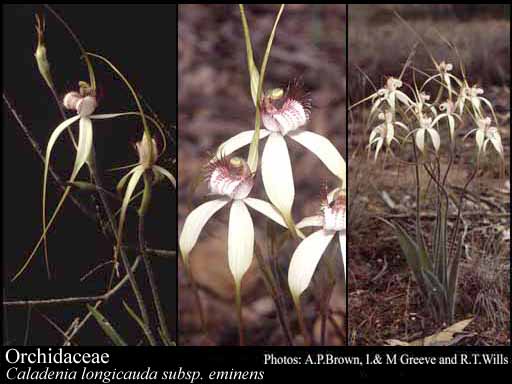- Reference
- Gen.Pl. [Jussieu] 64 (1789)
- Name Status
- Current

Scientific Description
Common name. Orchid Family.
Habit and leaf form. Herbs (of diverse forms), or herbaceous climbers. ‘Normal’ plants, or switch-plants, or plants of very peculiar form (some producing but a single leaf, some achlorophyllous, two species completely subterranean); sometimes with the principal photosynthesizing function transferred to stems, or ‘cactoid’; sometimes no clear distinction between stems, roots and leaves, the stem bearing photosynthetic appendages equipped with animal-trapping bladders. Leaves well developed, or much reduced, or absent (sometimes). Plants succulent (often), or non-succulent; autotrophic, or saprophytic. Perennial; plants with a basal concentration of leaves, or with neither basal nor terminal concentrations of leaves; cormous, or rhizomatous, or tuberous (or ‘pseudobulbs’). Self supporting, or epiphytic (predominantly), or climbing. Helophytic, or mesophytic, or xerophytic. Leaves small to large; alternate (usually), or opposite (rarely), or whorled (rarely); spiral, or distichous; ‘herbaceous’, or leathery, or fleshy, or membranous; imbricate, or not imbricate; petiolate; sheathing. Leaf sheaths tubular. Leaves edgewise to the stem, or with ‘normal’ orientation; simple; often jointed at the hase of the blade. Leaf blades entire; flat, or folded, or rolled, or solid; generally linear, or lanceolate, or oblong, or ovate; parallel-veined; cross-venulate (usually), or without cross-venules; auriculate at the base, or cordate, or hastate, or sagittate, or attenuate at the base, or cuneate at the base, or oblique at the base, or rounded at the base. Leaf blade margins usually entire. Vernation conduplicate, or plicate, or convolute. Vegetative anatomy. Plants with silica bodies (in idioblastic ‘stegmata’, which are ‘present in the leaves of many genera’). Stem anatomy. Secondary thickening absent. Roots. Roots with velamen (in epiphytic forms), or without velamen.
Reproductive type, pollination. Fertile flowers hermaphrodite. Unisexual flowers absent. Plants usually hermaphrodite. Floral nectaries present. Nectar secretion from the perianth, or from the gynoecium (extrafloral nectaries also widespread). Entomophilous. Pollination mechanism conspicuously specialized (in great variety, with complex morphological adaptations to the behaviour of pollinators, and often involving hygroscopic movements of pollinia).
Inflorescence and flower features. Flowers solitary, or aggregated in ‘inflorescences’; in panicles, in racemes, in spikes, in heads, and in umbels. The terminal inflorescence unit racemose. Inflorescences scapiflorous, or not scapiflorous; terminal, or axillary. Flowers small to large; fragrant, or odourless; very irregular; zygomorphic (the inner median member being generally enlarged and different in colour, forming the characteristic labellum —this being posterior (adaxial), but usually appearing anterior (abaxial) through torsion of the pedicel); resupinate (usually), or not resupinate (in Orthopenthea, some species of Disa, Anochilus, Herschelianthe etc). The floral asymmetry involving the perianth and involving the androecium. Flowers 3 merous; cyclic; supposedly basically pentacyclic. Perigone tube absent. Perianth of ‘tepals’ (usually), or with distinct calyx and corolla (the outer members sometimes green); 6; 2 -whorled; isomerous (but zygomorphic); free, or joined (two or more tepals often coherent at the base, sometimes adherent to the gynoecium); petaloid, or sepaloid and petaloid; without spots, or spotted (occasionally). Calyx (if the outer whorl be so designated) 3 (the median member usually ostensibly posterior); 1 -whorled; polysepalous, or partially gamosepalous, or gamosepalous. Corolla (i.e. the members of the inner whorl) 3; polypetalous, or partially gamopetalous, or gamopetalous; imbricate; (labellum) spurred (often), or not spurred. Androecium 3. Androecial members free of the perianth, or adnate (via fusion of tepals and gynostemium); united with the gynoecium (nearly always fused with the style to form a ‘gynostemium’, except in rare cases when anthers and stigma are more or less sessile); coherent (via the gynostemium); 1 - adelphous; theoretically 2 -whorled. Androecium including staminodes. Staminodes 2 (these anterior (usually ostensibly posterior), supposedly the abaxial pair of the inner whorl). Stamens 1 (this across the flower from the labellum, i.e. anterior but usually ostensibly posterior, supposedly representing the outer whorl); reduced in number relative to the adjacent perianth; alterniperianthial (i.e. with reference to the single stamen, across the flower from the labellum); filantherous, or with sessile anthers. Anthers dorsifixed to basifixed; dehiscing via longitudinal slits; introrse; tetrasporangiate; appendaged, or unappendaged. Pollen shed in aggregates (usually), or shed as single grains (monads known in about 17 genera); when in aggregates, in tetrads, or in the form of pollinia (the single grains or tetrads held together by strands of sterile sporogenous material). Gynoecium 3 carpelled. The pistil 1 celled. Carpels isomerous with the perianth. Gynoecium syncarpous; eu-syncarpous; inferior. Ovary unilocular; 1 locular. The ‘odd’ carpel anterior (away from the labellum). Gynoecium stylate. Styles 1 (inflexed); apical. Stigmas 1; 3 - lobed (but becoming much modified in form, the apex of the median lobe forming the ‘rostellum’); wet type; papillate; Group III type. Placentation parietal. Ovules not differentiated; in the single cavity 30–100 (i.e. very numerous); non-arillate; anatropous.
Fruit and seed features. Fruit fleshy (sometimes), or non-fleshy; dehiscent (usually), or indehiscent; a capsule (usually), or a berry (e.g. some Vanilleae). Capsules septicidal, or loculicidal. Fruit 30–500 seeded (i.e. seeds usually very numerous). Seeds endospermic (endosperm development arrested very early), or non-endospermic; minute; without starch. Embryo rudimentary at the time of seed release (usually), or weakly differentiated; chlorophyllous (6/7). Seedling. Seedling collar not conspicuous. Primary root ephemeral.
Physiology, biochemistry. Photosynthetic pathway: C3 and CAM.
Geography, cytology, number of species. World distribution: cosmopolitan, most abundant in the tropics. X = 6–29 (or more). 17000 species.